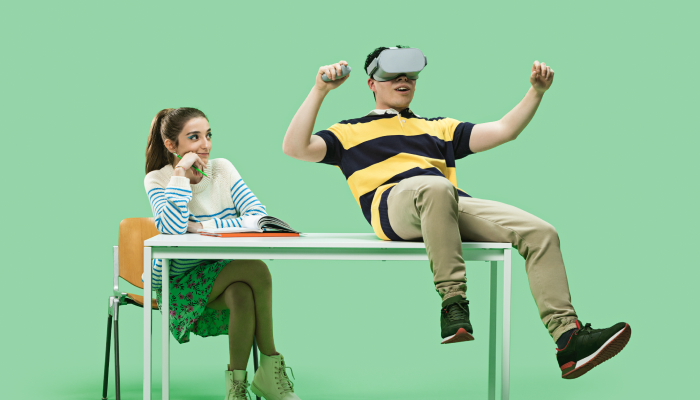Universal Design for Learning
Home » Universal Design for Learning
How can someone design a unique learning experience that will work for anyone, anywhere?
This is the question the Universal Design for Learning (UDL) framework aims to answer.
UDL is a set of guidelines to create inclusive learning environments beneficial to people of all abilities and backgrounds. This approach acknowledges that not everyone learns in the same way and that multiple ways of learning should be addressed.
Indeed, UDL provides strategies for multiple means of engagement, or different ways to motivate learners, content representation (or presenting the same content in different ways) and action (or ways to express what was learned).
Why is it so effective? Because this methodology also addresses the specific brain structures involved in each learning phase and is based on the neuroscience of learning.
Breaking barriers
The UDL story starts by breaking down universal barriers to learning, which prevent people from having positive learning experiences. These include blockers that most people have experienced in one situation or another, from bias, fear of failure, and lack of motivation, to inaccessible content that is difficult to understand.
The UDL guidelines shield learners from these barriers by providing an alternative route.
Creating a new reality
Summing up: to bring an inclusive learning environment to life is to break down barriers to learning and build a safe, diverse, and flexible learning path. Here are the three principles of UDL explained, with some concrete examples of how to implement them in any learning environment.
MULTIPLE MEANS OF ENGAGEMENT
First, motivation is essential to learning, and not everyone is motivated by the same things.
The first principle of UDL suggests creating multiple means for motivating learners in three areas: interests, persistence, and self regulation. The guidelines also provide examples of what these means could be, including
- Interests: Polls, eye-catching visuals, and thought-grabbing, relevant case stories get attention;
- Persistence: Increasingly challenging activities and opportunities for collaboration sustain effort;
- Self regulation: Opportunities for self evaluation and reflection strengthen learner independence.
MULTIPLE MEANS OF REPRESENTATION
Secondly, people perceive, process, and comprehend information in different ways.
The second principle of UDL states that presenting the same information in various modalities makes the learning process more inclusive. For example:
- Perceive: Video content includes captions, transcripts, and as an added bonus - is transcribed into a document;
- Process language: Acronyms, shorthand expressions, and any technical terms that the audience would not be expected to know are explained;
- Comprehension aids: Diagrams, charts, case studies, and examples are used to highlight key ideas.
MULTIPLE MEANS OF ACTION AND EXPRESSION
Lastly, people not only comprehend, but also best express what they know in different ways.
To this end, UDL provides strategies for interacting, submitting, and monitoring assignments in flexible ways. For example:
- Interact: Assistive technologies, alternatives, support tools (like calculators and spell checkers), and timing flexibility instead of limits is allowed;
- Submit: Assignments can be submitted in different formats chosen by the learner and multiple means of assessment are provided (think - debate, critique, problem-solving, and peer review);
- Monitor: Clear instructions, rubrics, feedback, checklists, and templates organize the learning process.
According to neuroscience research, the three areas of UDL align with the brain areas responsible for carrying out these learning processes: engagement via the affective neural networks, representation by the recognition networks, and action as the job of the strategic networks. In short – the why, what, and how of learning are all considered.
How to activate UDL on WeSchool
WeSchool’s features allow you to create more inclusive lessons. How? Here are three tips for bringing each of the UDL principles into a training experience or classroom with the support of the WeSchool platform.
-
 Show teaching materials in many different formats: In the Lessons area, you can upload teaching materials and content in many different formats, from .doc and .pdf documents to web pages, images, and videos directly from YouTube.
Show teaching materials in many different formats: In the Lessons area, you can upload teaching materials and content in many different formats, from .doc and .pdf documents to web pages, images, and videos directly from YouTube. -
 Create different types of exercises: In the Assessments section, you can create various types of exercises or tests: crossword puzzles, video quizzes, card matching, and more. This allows learners to test their knowledge and skills in different formats as they proceed, checking what learning objectives they have achieved on their personalized path.
Create different types of exercises: In the Assessments section, you can create various types of exercises or tests: crossword puzzles, video quizzes, card matching, and more. This allows learners to test their knowledge and skills in different formats as they proceed, checking what learning objectives they have achieved on their personalized path. -
 Foster engagement and motivation: Within a WeSchool Group, you can place deadlines and deliverables on the Calendar so that students can monitor their own progress and keep an eye on the entire course.
Foster engagement and motivation: Within a WeSchool Group, you can place deadlines and deliverables on the Calendar so that students can monitor their own progress and keep an eye on the entire course.
Pro tip: You can send encouragement messages whenever your students reach a certain milestone or complete a task to boost their resilience and long-term motivation.
Learning redesigned
All in all, “universal” in the context of Universal Design for Learning means not one-for-all, but something for everyone. UDL guidelines are a special superpower for anyone in charge of creating a learning environment for others. Powers activated: common barriers to learning are overcome and multiple healthy means of learning are introduced.
Jump right back in
Ready to to make learning more inclusive?








